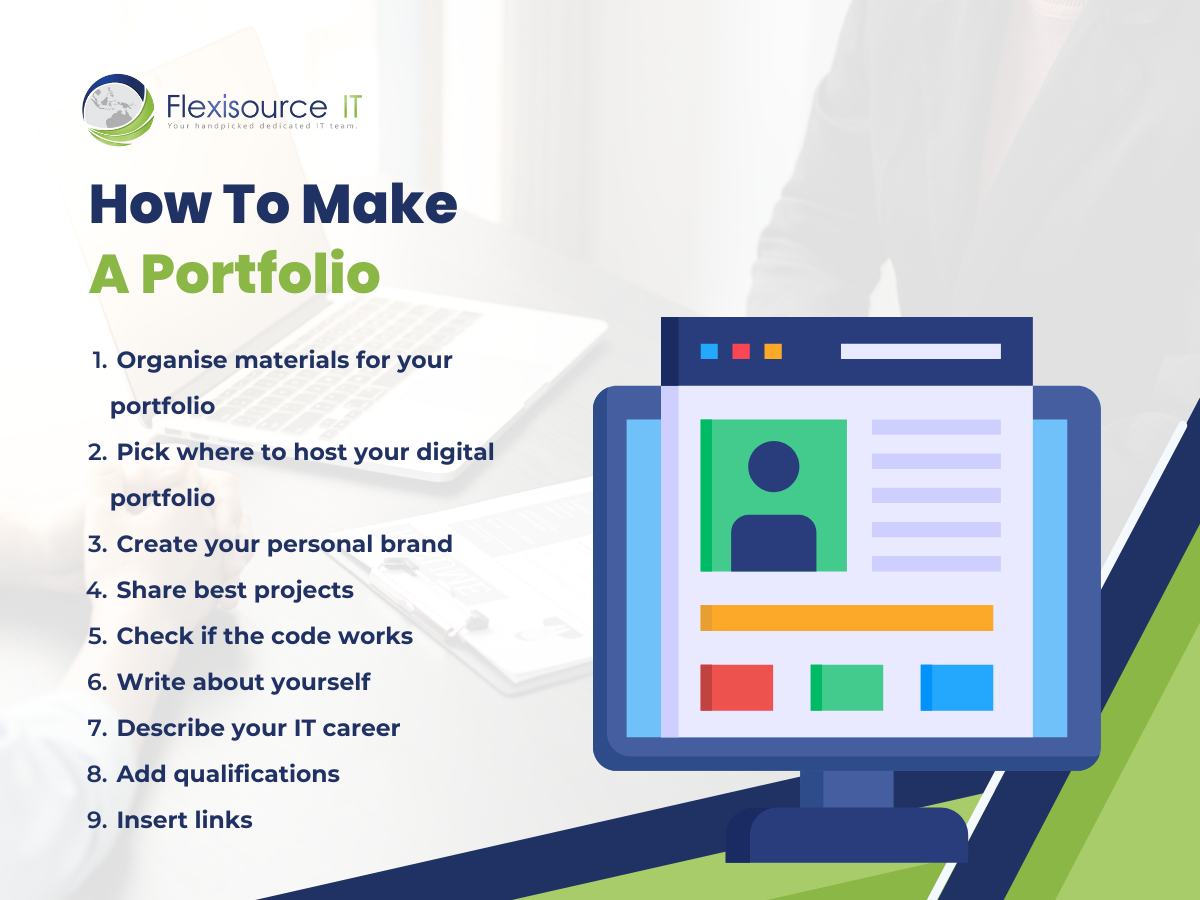Ready to take your career to new heights? Whether you’re a seasoned professional or just starting out, an impressive portfolio can be the game-changer you need to land that dream job. Given today’s competitive job market, knowing how to make a career portfolio can give you the edge you need.
In this article, we will guide you on the process of how to make a career portfolio that will set you apart from your competition and help your IT career.
What to include in your portfolio
Making a portfolio may seem straightforward. However, it is a valuable collection that showcases your professional experience, knowledge, and skills to potential employers—even clients, if you are working freelance.
It is different from your resume or cover letter, which describes and markets your capabilities in a short document. On the other hand, when creating a portfolio it should go into greater detail and show a comprehensive package of the following details:
- Education
- Training
- Certifications
- Skills
- Abilities
- Resume
- Accomplishments
- References
How To Make A Portfolio
With that said, you already have a checklist of the things you need to add. Now, let us move into creating a portfolio.
There are plenty of “how to make a portfolio for a job” examples available on the internet. However, at best, it can serve as a rough guide on what you need to include. So, in this article, we are going into more detail to give you a better idea.

Organise materials for your portfolio
The first thing how to make a career portfolio is to collect all the materials you need to put into your portfolio. You can check the list mentioned before for the information you need.
One way to do it is by looking through your resume. It already has a summary of the necessary information. You can consolidate it with supplementary information from your old projects, certificates, letter of recommendation, records, awards, and similar documents.
After that, you need to organise and arrange the details on your portfolio in a way that allows potential employers to easily find and understand the information you provide. A good way to do this is by starting with your bio and skills at the beginning then categorise your previous project from most recent to oldest to showcase your progress.
One thing to keep in mind is that you need to organise the items based on their importance. Furthermore, if you plan to present a print version of your portfolio, make sure to include a title page, table of contents, and page numbers.
Pick where to host your digital portfolio
One thing you should think carefully about how to make a career portfolio is where you will host it. There are plenty of options to choose from, you can opt to build a dedicated website or choose platforms specifically designed to help you create a portfolio.
Another option to consider is to go for a website builder. This alternative saves you a lot of time and effort yet still provides enough freedom. You can choose from the available templates and add features to further personalise it.
You should also consider customising your website URL. Having a personalised domain that includes your name is vital because this makes it easier for people to identify and find your website effortlessly.
Create your personal brand
A portfolio usually documents everything you have done as a working professional. However, if you really want to stand out and catapult your career in IT—or in any sector really—then you need to develop your personal brand.
Here are a couple of tips to help you build a strong and memorable brand:
- Get to know your market. There are plenty of resources online that showcase what more potential employers look for when hiring a capable IT talent. You can also check the top companies in the specific field that you want and understand their goals and challenges as a starting point as well.
- Highlight your unique selling points (USPs). Think back on your past experience and ask yourself, “What do you bring to the table?” or “What sets you apart from your professional peers?” Articulate how your USP can make a difference for your potential client or employer.
- Promote yourself. If you have a LinkedIn account and others like it then you already did half the job. Now, you need to showcase your technical expertise on these platforms and even on your dedicated website.
- Cultivate a positive reputation. Social proof like testimonials from your previous teammates, employers, and clients can be a powerful strategy to bolster your credibility and brand.
- Be consistent. Your name, username, profile picture, and colour palette should be the same throughout all your platforms, especially for your portfolio. This makes your personal brand more recognisable and memorable.
Share best projects
When you are thinking of how to make a career portfolio it is crucial to make wise choices. While it might be tempting to include all your projects on your portfolio website, it is recommended to focus on your best work.
The reality is hiring managers do not have the time to go through everything on your portfolio. Instead, they are looking for projects that best align with their field and goals.
To ensure you are showcasing your best projects, here are three tips to help you choose which ones to include:
- Consider the reviews. If a particular project received glowing reviews from a client, make sure to feature it in your portfolio. This serves as a powerful one-two punch, showing a tangible example of your work and highlighting the satisfaction of previous clients.
- Highlight projects with praise or awards. if a project or piece of work has received high recognition from clients or, better yet, won awards, then that is definitely something to add to your portfolio.
- Showcase projects that showcase your skills across a range of areas. For example, if you are a full-stack developer for a project then be sure to showcase what you did and how you troubleshoot its problems.
Check if the code works
One thing you should never overlook, if you are wondering how to make a career portfolio, is to ensure your code is actually working by checking it. Keep in mind, potential employers might take a look at the code to see how it is built.
This is especially important if you personally built your portfolio website. So, make sure it is tidy and clean. A couple of things to also check are the following:
- Links
- Images
- BUttons
- Web pages
- Responsive design
- Mobile-friendly
Write about yourself
Letting your potential employers and clients know about you is a crucial detail when thinking of how to make a career portfolio. The “About Me” section is where you can share a brief paragraph or two about yourself as a professional. Feel free to include your name, contact information, and even a photo if you like.
Keep in mind, this is an excellent opportunity to build your personal brand or tell your unique story.
Describe your IT career
Related to the one above is about detailing your IT career. This is the part where you let potential employers or clients gain a better understanding of your professional background, expertise, and capabilities.
Here, you should highlight your career accomplishments. You can showcase the value you bring to the table and differentiate yourself from other candidates. In addition, it helps you establish credibility and build trust.
Add qualifications
Another thing to check off on your list of how to make a career portfolio is your qualifications. This part is meant to incorporate additional essential information that showcases your qualifications to potential employers and clients.
Here are the things you need to add to your qualifications:
- Awards or contests you have participated in before
- Educational background
- Certificates
- Licenses
Feel free to mention scholarships, academic honours, or any awards you have received prior to starting your career. Highlighting these accomplishments will demonstrate the impact you have made and why you were chosen for specific awards.
Insert links
Now for the finishing detail: Links. You can add links to your other channels like your LinkedIn profile, a digital copy of your updated resume and cover letters, your social media profiles, and past projects.
Just remember to keep in mind that these have to be professional or career-related social media accounts. In addition, before sharing links, make sure these are correct, working, and lead to active and up-to-date websites.
Creating An Impressive Portfolio Can Make A Difference
When it comes to how to make a career portfolio, achieving a well-crafted portfolio cannot be overstated. It has the potential to make a significant difference in your career trajectory. And, when done right, can leave a lasting impact on potential clients and employers.
Remember, your portfolio is a dynamic representation of your skills, expertise, and USP. So, whether you are a seasoned professional or a fresh graduate, investing time and effort into building a compelling portfolio is a worthwhile endeavour.
With that said, so long as you create a good portfolio, it can help you stand out in a crowded job market. Take the knowledge you have learned and start creating your own impressive career portfolio.
Start your IT career with Flexisource IT! Drop your resume and join our team!







